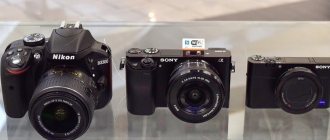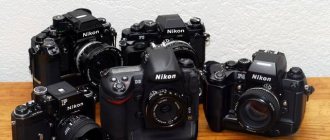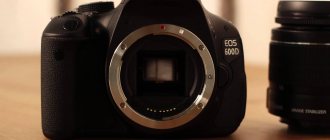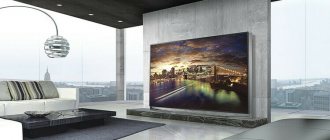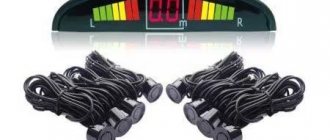What is a SLR camera?
A DSLR is a camera whose viewfinder is based on a mirror. In general, there are single-lens and double-lens SLR cameras. But since in the world of digital photography there is only room left for the first type, it will be discussed further.
The first single-lens reflex camera appeared in 1861. Yes, while serfdom had just been abolished in Russia, the camera had already been invented in England. That is, the history of the SLR camera began in the century before last, more than 150 years ago.
Of course, the first SLR cameras were very different from what we have now. One of the differences is the use of film. Today, film, as you all know very well, is practically extinct and exists only thanks to enthusiasts who fell in love with film photography once upon a time. Digital technologies have made it possible to replace the film in the camera with a matrix.
Let's return to the design of a SLR camera. Every DSLR has a mirror-based viewfinder. The mirror stands at an angle of 45 degrees and allows you to see a real non-digitized image through the viewfinder. The mechanism, in general, is quite simple from the point of view of understanding. Through the lens, light (and the image, respectively) enters the camera body, where a mirror is installed at an angle of 45 degrees. The light reflected by the mirror rushes upward, where it enters a pentaprism (or pentamirror), which wraps around the image, giving it its normal orientation. Simply put, if there were no pentaprism, the image in the viewfinder would appear upside down. That's all. This is the optical viewfinder - a distinctive feature of any DSLR.
Mirrorless cameras: advantages and disadvantages
Share this article:
A new step in the evolution of cameras has become mirrorless lenses - cameras without a mirror system and an optical viewfinder. They are lighter and more compact than DSLRs, have many advantages, and are not inferior in quality to the resulting images. What differences do these two systems have? A few years ago there were no professional cameras other than DSLRs; you had to choose a brand and model. But they have several significant drawbacks, the first and main one being their dimensions. DSLRs are heavy and large, and fragile optics require careful handling; you have to purchase an additional bag. Mirrorless cameras have partially solved this problem; the device is still a fragile technology, but the dimensions are comparable to a point-and-shoot camera.
The content of the article:
But for photographers, the advent of compact cameras has added challenges when choosing a model. Now you need to know the differences between the two types and decide on the conditions for using the equipment. To understand the operating principle of a mirrorless camera, or BZK, you need to understand the structure of the optical mirror system.
SLR camera design
In the camera body, between the fixed lens and the matrix itself, there is a working space; DSLRs have an optical system consisting of two mirrors located one behind the other, a pentaprism and a phase detection autofocus sensor.
When light hits the lens, it passes to the mirrors, is reflected and flipped, and the image is displayed in real time on the screen. The first large translucent mirror reflects most of the light onto the pentaprism, and transmits some light to the small opaque one behind it. The image is fed into the viewfinder already inverted, reflected from the prism. And part of the light reflected from a small mirror is supplied to the sensor. Thus, the mirror system acts as a transmitter, and when the shutter button is pressed, the elements rise and the light passes onto the matrix.
The design significantly increases the size of the body and the distance from the matrix to the bayonet, as well as the weight of the camera. And for long-term street filming, the dimensions and weight of the camera are very important indicators.
Mirrorless device
Cameras of this type are in many ways similar to SLR cameras; the design has a large matrix and the ability to change lenses. But another important detail is missing - a system of mirrors, a pentaprism. This way light passes directly from the lens to the matrix, without refraction or distortion.
Once on the matrix, the information is perceived by the processor and sent to the camera display in real time. When you press the button, the shutter is released, which determines the degree of opening of the aperture. The phase detection autofocus sensor in such cameras is located on the matrix.
Thus, mirrorless cameras have significantly smaller dimensions than DSLRs and are relatively lightweight. When traveling or on walks, when shooting is done handheld and the camera must be in working condition, ready to shoot, compactness is an important factor and property of the camera.
There is a third type of camera - compact cameras, or “point-and-shoot cameras,” as they are popularly called. They do not have a mirror system and there is no ability to change the lens. These cameras are lightweight and relatively small in size, but are very limited in capabilities and produce passable results, suitable only for decorating home photo albums.
Advantages of a mirrorless camera over DSLRs
Comparing the 2 types of cameras, you can find the advantages of a camera with a mirror system or a UPC, as well as the disadvantages of both. And most parameters can only be understood by comparison with long-term intensive use. These include professional settings and design features; these little things add up to 18 points.
- The weight of the camera plays a big role during long handheld shoots where you carry the equipment while working. The difference in the weight of the cameras themselves without optics is relatively small, but even 300-500 grams can make life and the shooting process much easier.
- And the weight of the BZK is less than that of a DSLR only due to the lack of a mirror system; other parts are similar.
- The dimensions of the camera without a mirror system are a couple of centimeters smaller in width, but when using a full-frame model, this difference is insignificant. The camera still doesn't fit into a pocket like a point-and-shoot camera, and it also requires a bag. But many UPCs are significantly smaller than their counterparts with mirrors and take up less space in a backpack.
- Quiet operation is not an important parameter, rather a pleasant detail. The shutter and the entire mechanism produces significantly less noise, almost silently “slamming”. This is a relevant moment when photographing important events, business meetings or solemn touching situations at weddings or baptisms.
- The manual focus accuracy of mirrorless cameras is an order of magnitude higher than that of their DSLR counterparts. This is achieved by the Focus Peaking function, which shows the subject in focus or the area of the frame.
- Improved low-light focusing takes the BZK a step above when using cameras for night photography.
- Focusing when recording video is an order of magnitude higher than that of DSLRs, because the latter only have contrast autofocus, and it works very poorly. When the shutter is open, the mirrors cannot be rotated, which negates the focus system of DSLR cameras.
- Another advantage when focusing is a large number of focal points in the frame ; they are placed much better in the BZK, which makes it possible to obtain clearer and sharper pictures.
- The viewfinders of mirrorless cameras allow you to see the distance to focus , which is especially important when shooting at night or in low light.
- If you need to focus at infinity, then it is easier to do this on the BZK, since this scale is less accurate on DSLRs.
- Zebra and histogram . The BZK has a function that highlights underexposed areas in the frame in real time and displays information on the viewfinder. Zebra is very convenient when shooting time is limited; there is no need to take sighting shots.
- The same is true for the histogram; DSLRs can display it only on the finished image; a preliminary assessment is only possible when light hits the matrix directly. And mirrorless cameras display information on the display or viewfinder.
Previewing during night photography is only possible without a system of mirrors, which greatly narrows the already small stream of light entering the viewfinder. With SLR cameras, you need to take pictures for testing and change the settings based on the finished frames. BZKs are free of this inconvenience; they take the desired picture in a couple of minutes by adjusting the ISO directly in the viewfinder.
- Batch shooting speed. In a DSLR camera, you have to raise the mirrors from the sensor and lower them to take each frame, so they take repeated pictures slowly. And the absence of a reflection system is a powerful advantage of the BZK; there are camera models that shoot up to 20 frames per second. – an unattainable milestone for DSLR cameras. In this case, the camera autofocuses for each shutter click and the edges of the image are not darkened, which is a problem with some DSLR models.
- Face detection and automatic focusing on it often help to quickly set the white balance and overall color balance of the frame.
- If you do not want to use a lens from the same company designed for your camera model, you can install another one using adapters.
- Previewing effects without overlaying them on a saved image will provide a unique opportunity to evaluate the scope of work before it begins. The camera shoots and saves it in RAV, and you can set effects on the display, for example, filters or black and white mode.
- This can greatly reduce the time spent on post-processing images or selecting images according to the idea. DSLRs are completely deprived of this opportunity; the frame is first shot in real form, and then converted by the program into the desired version.
- Permission to bring a camera is a separate problem for every photographer; for many security guards, the lens on the camera is already professional equipment. And mirrorless cameras look like compact point-and-shoot cameras without optics, or with small lenses, and most often do not raise questions at sports matches, in museums or exhibition centers.
- Mirrorless cameras are designed a little simpler than DSLRs , so many functions are switched to automatic mode. For a beginner and non-professional photographer, this will be an excellent help in filming.
- The BZK is slightly cheaper than similar cameras , but with mirrors. Although recently more and more expensive models have appeared and soon this advantage will disappear.
- Fewer reasons for breakdowns . The mirror system is fragile, so the camera should be used and carried very carefully. When shaken and dropped, they fail very quickly; the UPC also cannot be dropped or shaken strongly, but their mechanism is a little simpler, so they break less often.
Disadvantages of a mirrorless camera
Despite all the advantages and disadvantages, cameras without a mirror system also have a number of significant disadvantages, losing to DSLR cameras. A significant drawback is the difficulty in selecting and finding accessories, flashes, and lenses for each model. In a couple of years this situation will be resolved due to high demand, but for now it is very difficult to find the necessary equipment.
Another inconvenience is transferring settings from the case to the display sensor, so you need to get used to looking for the necessary parameters, and not setting them with buttons and knobs. UPCs are made as compact as possible, which sometimes comes to the detriment of functionality.
The electronic viewfinder makes working with the camera a little more difficult; at the moment it is not ideal and loses in comparison with the optical one. It's a little slower, the response time is a little longer, and the contrast performance is higher. But its advantages more than outweigh this small disadvantage.
Many photographers note a significant disadvantage of the BZK - the battery capacity and battery life are 2-3 times less than those of DSLRs. If the latter can take 700-800 pictures, then the display and other functions of mirrorless cameras will “eat up” half the charge and the figure will be 300-350 frames.
For now, UPCs are practically unsuitable for working in open areas or at sports competitions due to contrast focusing. Some models are already equipped with a combined, or hybrid, autofocus system, but it is still far from ideal, especially in conditions of continuous subject tracking.
Summing up the comparison
Each photographer has experience with different cameras and types of cameras and, of course, his own subjective opinion. Therefore, it is very difficult to say unambiguously what is suitable and what is not. Some people care about autofocus parameters, others focus on weight and dimensions at the expense of some features, and others choose the lowest cost of the presented models. Having received what they want, every photographer will praise his technique, regardless of its objective advantages or disadvantages. Undoubtedly, each generation of cameras has its own strengths and advantages, and there are technologies that greatly simplify working with cameras.
Film cameras have outlived their usefulness many years ago, but there are still fans and specialists who recognize only this type of shooting, making strong arguments in favor of the quality of photographs from film.
Also, many years from now there will be those who will shoot with the DSLRs of our time and produce excellent results, convincing everyone that this is the only correct mechanism. And there will be amateurs who will argue that you can take wonderful shots with a point-and-shoot camera and that nothing more is required.
The only conclusion in this situation can be the following: you need to try different types and models and choose a camera for your needs and requirements. Only then will the mechanism, the type of camera and its technical characteristics suit you.
And time does not stand still, every day new technologies and models are tested and released for sale, different combinations of capabilities and functions are assembled, and new software appears. Time will tell which technology is the future.
Share this article:
I liked the article
Discuss the article
What is a mirrorless camera?
A mirrorless camera, just like a DSLR camera, has interchangeable lenses. But, as you understand from the name, it does not have a mirror viewfinder. Inexpensive cameras use a screen instead of a viewfinder, while more expensive cameras use an electronic viewfinder. In fact, unlike an optical viewfinder, such a viewfinder shows us a digitized image. We can say that this is a small screen. It has a certain resolution, which is indicated in the camera specification. Naturally, as with a monitor, the higher the resolution, the better.
Why is a DSLR camera better than a mirrorless camera?
Let's first talk about why a DSLR is better than a mirrorless one.
- An optical viewfinder is not only a feature of a DSLR camera, but also its advantage over a mirrorless one. There are several reasons for this. First, the optical viewfinder shows the image in real time, raw and undigitized. That is, as your eye would see it without a viewfinder. Secondly, when using an electronic viewfinder there is a slight delay in the image, which is not present with an optical viewfinder. Those. with the latter you always see the picture in real time.
- Phase detection autofocus is unique to DSLR cameras. The latest models of mirrorless cameras have learned to use phase sensors on the matrix, thereby giving birth to a hybrid focusing system, but today it still does not reach the focusing speed of a SLR camera.
- DSLRs have better ergonomics This is due, among other things, to the fact that the mirror itself with the pentaprism takes up quite a lot of space in the carcass. Because of this, in fact, these cameras are so large. But this minus turns into a plus when you need to control the camera: especially professional cameras have excellent access to all important functions using buttons, wheels and other controls located on the body. Particularly noteworthy is the additional monochrome display, which is found in large SLR cameras and is never found in mirrorless cameras. This display is very helpful in professional photography, and it is never superfluous for amateur photography.
- Huge optics park . Remember when we said that SLR cameras have been produced for a century and a half? Nikon began producing cameras in the 50s of the twentieth century. Today, Nikon's optics fleet is huge and continues to grow. Of course, mirrorless cameras are still far from achieving such richness.
- DSLR cameras are generally less expensive Specific example. There is a Nikon D5100 with a Nikon 35mm 1.8G DX lens. This is a very inexpensive kit, costing less than 20 thousand. To get similar quality with a mirrorless camera you need to spend a lot more money.
- A DSLR camera turns on much faster than a mirrorless camera. In a split second, while mirrorless cameras can turn on in 3 seconds.
- life of DSLR cameras is significantly longer than that of mirrorless cameras. And the batteries themselves are usually more capacious. Thus, amateur cameras like the Nikon D7100 can shoot one and a half thousand frames on a single charge. Professional equipment, like the Nikon D4, can take more than 3 thousand pictures with a single battery charge.
- DSLR cameras are more reliable . Some of them have dust and moisture protection. This is why you are unlikely to see a photographer with a Sony A7 in the savannah. But with Canon 1Dx there is nothing to do. There are more of them there than lions and bison...
So, the main thing: today, professional shooting with a mirrorless camera is almost impossible. A DSLR camera is preferable for commercial photography. And the amateur must decide for himself whether the advantages of a DSLR are important to him, or whether what a mirrorless camera offers is enough. More on this below.
Limitations of DSLR cameras.
1. Dimensions. The reflex system needs space for the mirror and prism, which means that DSLRs will always have a massive body with a block protruding from the top. This also means that the viewfinder must be mounted in the same place on any DSLR camera, in line with the optical axis and digital sensor, and there is virtually no other place for it. As a result, most DSLRs have an identical appearance.
2. Weight. Larger sizes actually mean more weight. Although most entry-level DSLRs have plastic controls and internal components to reduce weight, having a mirror and pentaprism automatically means a lot of unused space that needs to be covered. And covering such a large area of the body with a thin layer of plastic would not be wise, because the fundamental idea of DSLR cameras is also their durability. Additionally, DSLR lenses tend to be quite large and heavy (especially full-frame lenses), so the weight balance between body and optics must also be maintained. Essentially, the large physical size of a DSLR camera directly impacts its weight.
3. Mirror and shutter. Each shutter release means the mirror moves up and down to let light directly onto the sensor. This in itself creates a number of questions:
- clicking of the mirror. Most of the noise you'll hear from DSLRs comes from the mirror moving up and down (the shutter is much quieter). This not only results in noise, but also some camera shake. Although manufacturers have come up with creative ways to reduce noise by slowing down the movement of the mirror (Nikon's Quiet Mode, for example), it still remains. Camera shake can also be a problem when shooting at slow shutter speeds and long focal lengths.
- air movement. When the mirror is flipped, air moves inside the camera, which can move dust and debris that can eventually land on the surface of the sensor. Some users claim that DSLR cameras are better than mirrorless cameras due to safer lens changes due to the presence of a mirror between the sensor and the mount. There is a deal of truth in it. But what happens to the dust after moving the mirror inside the camera? Obviously, dust will circulate inside the case. In my experience with mirrorless cameras, they are actually less prone to dust intrusion than any DSLR.
— limiting the frame rate. While modern mirror systems and shutter mechanisms are truly impressive, they are limited by the physics of how quickly the mirror can be raised. When the Nikon D4 shoots at 11 frames per second, the mirror actually moves up and down 11 times within a second as the shutter fires. To do this, you just need perfect synchronization of the system. The video shows the slow motion of this mechanism (from 0:39):
Now imagine a speed of 15-20 responses per second? Most likely, this is physically impossible.
- high cost of camera and maintenance. The mechanism for raising the mirror is very complex and consists of a dozen different parts. Because of this, it is difficult to organize and provide technical support for such systems. Disassembling and replacing the internal components of a DSLR camera can be time consuming.
4. No LivePreview mode . When looking through an optical viewfinder, it is impossible to see exactly what it will actually look like.
5. Second mirror and accuracy of the phase method. You may already know that all digital autofocus cameras with phase detection autofocus require a second mirror. In fact, the second mirror is needed to transmit light to the detection sensors, which are located at the bottom of the camera. This mirror must be located at a clear angle and at a strict distance, because the accuracy of phase focusing depends on this. If there is even a slight deviation, it will lead to a loss of focus. And to make matters worse, the detection sensors and the second mirror must remain strictly parallel to each other.
6. Phase determination and optics calibration. The problems with the traditional DSLR phase detection method are directly related to minor issues such as mirror alignment, and also require the optics to be perfectly calibrated. In fact, this is a two-way process, because accurate focusing requires the ideal angle, distance from the second mirror to the sensors, as well as correctly calibrated optics. If you've had problems focusing your optics in the past, you've most likely sent your lenses to the manufacturer. Very often, the support service asks to send the lens along with the camera itself. After all, there are actually two options for where problems can arise.
7. Cost. Although manufacturers have improved the production system of DSLR cameras over the years, mounting DSLR mechanisms remains a challenging task. Many moving systems require high assembly precision, the need for lubrication at friction points of components, etc. Moreover, if something goes wrong with the mirror mechanism in the future, the manufacturer must repair or replace it, which is a time-consuming task.
Why is a mirrorless camera better than a DSLR?
Yes, but are there any advantages to a mirrorless camera that a DSLR camera doesn’t have? Eat. And now we will talk about them.
Olympus technology is one of the most popular mirrorless cameras on the market
- Size . This is the most obvious. Mirrorless cameras are smaller. The optics for such cameras are also more compact. As a result, you can get a mirrorless system that will be smaller than a DSLR, but will allow you to get the same high-quality images.
- Electronic viewfinder . Electronic viewfinders also have their advantages. Firstly, they can display various additional information. Secondly, such viewfinders will be more convenient for nearsighted people. You need to use the optical viewfinder with glasses or use the diopter correction function, which is enough for vision of -2.5, but if the minus is greater, then alas. The electronic viewfinder, as we said above, is a screen. And, of course, when used by a nearsighted person, there are no problems with it.
- Large selection of manufacturers . Mirrorless cameras are now produced by the following companies: Nikon, Canon, Sony, Panasonic, Olympus, Fujifilm, Samsung. But affordable DSLRs are produced only by the first 3 companies plus Pentax.
What do DSLR and mirrorless cameras have in common?
There is one thing that these cameras have in common.
- Matrix . The most important part of a digital camera. Just a couple of years ago, I would have said that mirrorless cameras do not have a full-frame sensor. But Sony corrected this by releasing the A7 series cameras. They have matrices that are not inferior to those used in SLR cameras. We have already talked about matrices more than once; there is no need to repeat ourselves.
- Systematicity . For some reason, many people call mirrorless cameras system cameras, forgetting that DSLR cameras also belong to this class. This is the similarity between DSLRs and mirrorless cameras - these are system cameras that feature interchangeable optics.
DSLR or mirrorless? Comparison of weight and dimensions
After using Nikon DSLRs for the past 10 years, I'm more impressed with DSLRs than mirrorless cameras: it's a system I can trust and that I see value in further developing. The DSLR can satisfy the needs of almost any genre and type of photography. At the same time, in the last few years I have gained experience shooting with new generation mirrorless cameras, which, in my opinion, are also quite attractive.
One of the advantages of switching to mirrorless cameras, which we are constantly told about, is their lighter weight and dimensions. But are mirrorless cameras so smaller and lighter than DSLR cameras that we can talk about such an advantage?
We have already considered this issue in detail and came to the conclusion that lower weight and size should not be considered the main advantage of a full-frame mirrorless camera over a DSLR. It's true that a mirrorless camera will always be lighter than its DSLR counterpart - it has fewer mechanical components and is thinner - but this difference is not so significant, and it only applies to the camera body itself.
First, it takes some time for a potential buyer to realize that “bigger is not always better.”
With a lens attached, a full frame mirrorless camera has no weight advantage over a DSLR with a lens! So if you have a backpack full of photographic equipment, then the only thing you can save space and weight on is the camera body. And once you add a couple of batteries to a mirrorless camera, its weight advantage becomes even less noticeable.
At launch, Sony's slogan was "Lighter and smaller", but by the time the Sony A7 Mk II was announced and the updated line of G-lenses, it became clear that Sony began to rely on excellent handling, ergonomics and professional quality lenses, rather than on advantages in weight and dimensions. And the new G-series lenses cannot be lighter than their SLR counterparts simply because it is impossible to defeat the laws of optics. While a shorter flange distance allows you to create a lens with some savings in weight and size, these savings will be insignificant.
Where mirrorless cameras really have a weight and size advantage is in the APS-C camera segment. Unfortunately, DSLR camera manufacturers have been extremely slow to offer attractive lenses for APS-C DSLRs. For example, if we compare Fujifilm lenses with Nikon DX lenses, we will see that among the former there is a much wider selection of lenses designed specifically for the Fuji X mount, while most Nikon DX lenses are represented by slow zooms that force users of the Nikon DX system sooner or later switch to more expensive, bulky and heavy full-frame FX lenses. From this point of view, mirrorless cameras are superior to their competitors, since lenses specifically designed for small sensors will always be lighter and more compact. Canon is no better in this regard - most of this manufacturer's APS-C lenses are also slow-aperture zooms.
What's better? DSLR or mirrorless?
There is no clear answer to this question. Everyone must make their choice based on their needs. My opinion is that DSLR cameras today are still too much superior to mirrorless cameras. For me personally, when choosing a camera, the most important criteria are speed (focusing, switching on), a wide selection of optics and price (both for the camera and lenses). Yes, you don’t always want to take a huge mirror set with you. It's better to have a choice. For example, for large (long, important, etc.) filming, have a DSLR, but for the soul - something small, maybe not even a mirrorless camera, but a compact camera like Fuji x100s or the like. But if you choose one single camera, then again, I would choose a DSLR. But that's just my opinion. What would you choose?
Related articles: Types of cameras How to choose a DSLR camera The best DSLR cameras 2014
